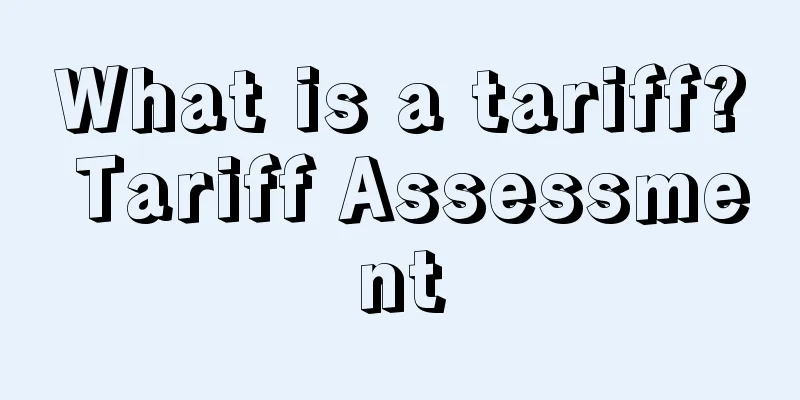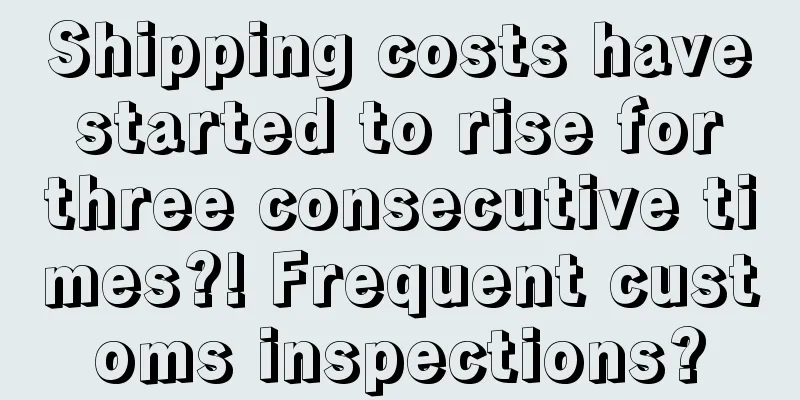What is a tariff? Tariff Assessment

|
Customs Duties ( Tariff ) is a tax imposed by the government on the importers and exporters when the imported and exported goods pass through the customs of a country . 1. Tax information Tariffs refer to a tax imposed by a country's customs on imported and exported goods passing through its customs territory in accordance with the country's laws. Tariffs are generally a high-level tax with a tax rate specified by the highest administrative unit of a country. For countries with developed foreign trade, tariffs are often the main source of national tax revenue and even national fiscal revenue. The government can impose tariffs on both imported and exported goods, but import tariffs are the most important and are the main trade measure. On December 23, 2020, the Tariff Commission of the State Council issued the 2021 tariff adjustment plan, deciding to implement a provisional import tariff lower than the most-favored-nation tariff on 883 items starting from January 1, 2021. Commodities closely related to people's lives, such as raw materials for anti-cancer drugs, hearing aids, and raw materials for infant formula, are among them. At the same time, as China continues to open up to the outside world, some agreed tariffs and most-favored-nation tariffs will also be reduced. 1. Collection The tax base of tariffs is the tariff-paid price. The CIF price of imported goods based on the transaction value approved by the customs is the tariff-paid price; the tariff-paid price of exported goods is the price determined by the customs after deducting the export tax from the FOB price of the goods sold abroad. That is: Duty-paid price = transaction value approved by the customs - CIF price; Dutiable price = [(export goods sales + overseas FOB price) - export tax] → customs approval. The calculation formula for the taxable amount of customs duties is: taxable amount = customs duty-paid price × applicable tax rate. 2. Features (1) Tariffs are taxes levied by the government’s customs on importers and exporters when import and export goods pass through a country’s border. (2) Tariffs are mandatory. (3) Tariffs are gratuitous. (4) Tariffs are predetermined. 3. Function 1. Safeguarding national sovereignty and economic interests 2. Protect and promote the development of domestic industrial and agricultural production 3. Regulating the national economy and foreign trade 4. Raising national fiscal revenue 4. Tariff Tariff schedule, also known as customs tariff schedule, refers to a country's regulations on the calculation of tariffs on imported goods and a table that systematically classifies imported taxable goods and duty-free goods. It is the basis for customs taxation and a concrete manifestation of a country's tariff policy. In terms of content, customs tariffs generally include two parts: one is the rules, regulations and instructions for customs to collect tariffs; the other is the tariff rate table. The tariff rate table is composed of columns such as tariff number, commodity name, and customs tariff rate. II. Tax Classification 1. Collection method Ad valorem tariff: tariffs are levied based on the price of imported and exported goods. Ad valorem tariff = total price of goods * ad valorem tariff rate Specific tariff: A quantitative tariff is levied based on the unit of measurement of the quantity of imported and exported goods (such as "tons", "boxes", "hundreds", etc.). Specific tariff amount = quantity of goods * specific tariff per unit Mixed tariff: A mixed tax based on value and quantity is levied on imported and exported goods according to various needs. Selecting tariff: refers to the situation where there are two tariff rates, ad valorem and specific tariff rates, for the same kind of goods in the tariff schedule. When levying taxes, the one with a higher tax amount is selected, or the one with a lower tax amount can be selected as the tax calculation standard. Sliding tariff: A tariff rate that is set from low to high as the price of imported goods changes from high to low. It can help stabilize the price of imported goods. 2. Commodity Flow Import taxes It is the normal tariff (Normal Duties) levied by the customs of the importing country on domestic importers when foreign goods are imported. Export Tax It is a kind of tariff imposed on the goods exported by a country when they are shipped out of the country. The imposition of export tariffs will increase the cost of exported goods and will be detrimental to the competition of domestic goods in the international market. Transit Tax A transit tax is a tariff levied by a country on foreign goods passing through its customs territory. Differential treatment and special circumstances Most-Favoured-Nation Rates and Ordinary Rates The most-favored-nation rate applies to goods imported from countries or regions that have signed a most-favored-nation agreement with the country. Ordinary tariffs apply to goods imported from countries or regions with which the country does not have such a trade agreement Normal import duties refer to most-favored-nation duties. Preferential Tax Preferential tariffs refer to the preferential low tariff or duty-free treatment given by a country or economic group to all imported goods from certain countries. There are reciprocal and non-reciprocal Typical examples of reciprocal preferential tariffs: Commonwealth preferential system Typical non-reciprocal preferential tariffs: Lomé Convention Three Principles of Generalized Tax and Preferential System Universal, non-discriminatory, non-reciprocal The basic objectives of the GSP ① Increase export earnings of developing countries ②Promote industrialization in developing countries Main Schemes of the GSP ① Provisions on the scope of beneficiary countries and beneficiary products ②Regarding the provisions on the place of origin Import surcharge · Price difference tax That is, the differential tax. When the domestic price of a certain domestically produced product is higher than the price of similar imported goods, in order to protect domestic production and the domestic market, a tariff is levied according to the difference between the domestic price and the price of imported goods. It is also called a sliding tariff and is the "gate price" for agricultural products in the European Union. Anti-dumping duties A type of import surcharge. The Tokyo Round of 1979 stipulates that "when a country exports a product to another country, the export price of the product is lower than the comparable price of similar products for domestic consumption in normal trade, it is considered dumping." The normal comparable price is the wholesale price in the domestic market of the exporting country. ·Conditions: There is dumping, causing major damage or threat to domestic industries, or seriously hindering the construction of a domestic industry. · Offset tax or compensatory tax is an import surcharge imposed on the import of foreign goods that directly or indirectly receive any bonus or subsidy Subsidy: refers to financial assistance provided by the government or any public institution to enterprises and any form of income or price support for export products by the government ·condition: ① The imported goods have received direct or indirect subsidies from the government, and the imported goods are prohibited by the WTO ② The subsidy causes significant damage or threat to the country's established industries or seriously hinders the construction of a domestic industry 3. Purpose of collection Fiscal tariffs The main purpose is to increase national fiscal revenue. It is usually levied on products produced abroad and with high domestic consumption demand. The tax rate is moderate. It is mostly adopted by developing countries and is no longer important for industrialized countries. Protective tariffs Levies are imposed to protect domestic economic industries, agriculture, etc.; Conditions for imposing fiscal tariffs: ① The import demand for goods is inelastic ②Tax rates should not be too high ③ The tax rate is so high that it completely prohibits imports, which is a prohibitive tariff. 4. Others retaliatory tariffs, punitive tariffs 3. Payment Methods The usual way to pay tariffs is for the customs to calculate the taxable tariffs for each ticket and fill out the tariff payment slip, which is accepted by the customs according to the customs clearance procedures for the formal import (export) of the imported (exported) goods. The taxpayer will go through the tax payment or transfer procedures to the customs or designated bank with the slip, and the customs (with the bank receipt) will handle the customs clearance procedures. The tax collection procedures are done first, and the customs clearance procedures are done later, which is conducive to the timely deposit of taxes and prevents tax arrears. Therefore, customs in various countries use this method as the basic tax payment method. IV. Tax Calculation 1. Ad valorem Ad valorem tax is a tariff levied based on the price of imported and exported goods. The price here does not refer to the transaction price, but the dutiable price of imported and exported goods. Therefore, to calculate tariffs based on ad valorem tax, the dutiable price of the goods must be determined first. The formula for calculating ad valorem tax is as follows: *Tax payable = quantity of taxable import and export goods × unit tax-paid price × applicable tax rate 2. From the quantity Specific tariffs are levied based on the quantity, weight, volume, length and area of commodities. Its characteristics are that the tax amount does not change due to fluctuations in commodity prices, and the calculation is relatively simple. The calculation formula for specific tariffs is as follows: *Tax payable = quantity of taxable imported goods × tariff unit tax amount 3. Composite Compound tax is also called mixed tax. It is a method of levying both specific tariff and ad valorem tariff on imported goods. Generally, the specific tariff is the main one, and ad valorem tariff is added. The calculation formula of mixed tax is as follows: *Tax payable = quantity of taxable imported goods × unit tariff amount + quantity of taxable imported goods × unit tax-paid price × applicable tax rate 4. Sliding accuracy Sliding tariff refers to a tax rate in which the tariff rate changes in the opposite direction to the price of imported goods, that is, the higher the price, the lower the tax rate, and the tax rate is a proportional tax rate. Therefore, when a sliding tariff is implemented, the calculation method of the tariff payable on imported goods is the same as the calculation method of ad valorem tax. The calculation formula is as follows: *Tariff payable = T1, 2 × P × exchange rate 5. Special The calculation formula for special tariffs is as follows: Special tariff = Duty-paid price × Special tariff rate Consumption tax at import stage = Dutiable price of consumption tax at import stage × consumption tax rate at import stage The duty-paid price of consumption tax at the import stage = (duty-paid price + tariff + special tariff) / (1-consumption tax rate at the import stage) Import VAT = Import VAT paid price × Import VAT rate VAT-paid price at import stage = tariff-paid price + tariff + special tariff + consumption tax at import stage 5. Tax Incentives Single goods with a tariff amount of less than RMB 50. Advertising materials and samples of no commercial value. Materials donated free of charge by international organizations and foreign governments. Necessary fuel, materials and food supplies for loading inbound and outbound transport. Materials, parts, accessories, etc. imported for processing are re-exported. Exhibits, construction machinery, instruments, etc. that are temporarily imported or exported with the approval of the customs and then re-imported or exported within 6 months are temporarily exempt from tax. Chinese export goods that are returned for some reason may be exempted from import tariffs, but the export tariffs that have been collected will not be refunded. Overseas imported goods that are returned for some reason may be exempted from export tariffs, but the import tariffs that have been collected will not be refunded. 6. Late Payment Fee Tariff late payment penalty refers to the administrative act of imposing a monetary payment obligation of a certain percentage of the tax payable on a taxpayer who fails to fulfill his tariff payment obligation within the tariff payment period. The purpose of levying late payment fees is to encourage taxpayers who are in arrears with their customs duties to fulfill their customs duty payment obligations as soon as possible by making them assume new monetary payment obligations. The late payment penalty is collected daily at the rate of 0.05% of the tax amount from the date of expiration of the tariff payment deadline to the date when the taxpayer pays the tariff. No deduction will be made on weekends or statutory holidays. The specific calculation formula is: Tariff delinquency fee amount = delinquent tariff amount × delinquency fee collection rate × number of days delinquent 7. Post-independence system The post-tariff payment system is a customs system that allows certain taxpayers to go through the procedures for releasing goods first after completing the relevant customs procedures, and then go through the procedures for collecting and paying customs duties. The post-tariff payment system is an alternative measure taken on the basis of the usual basic tax payment method for special circumstances such as perishable, urgent or relevant procedures cannot be completed immediately. The customs can release the relevant goods after taking samples of the goods, collecting deposits or accepting other guarantees from the taxpayers. The post-tariff payment system allows the customs to have sufficient time to accurately classify the tariff, determine the duty-paid price of the goods, determine their place of origin, etc., or allows taxpayers to have time to complete the relevant procedures, prevent the backlog of goods at the port, and put the inbound and outbound goods into use as soon as possible. 8. Impact Imposing tariffs is one of the ways for a government to increase its fiscal revenue, but with the continuous development of world trade, the proportion of tariffs in national fiscal revenue is constantly decreasing. Each country will impose certain taxes on imported and exported goods according to their types and values. Its role is to raise the price of imported goods through taxation, reduce their market competitiveness, and reduce the adverse impact on domestic products in the market. Tariffs have the function of protecting domestic industries, but in the era of economic globalization, their adverse effects are gradually emerging. The main impact is on the employment rate. IX. Foreign tax policies The United States' tax incentives have boosted domestic demand for wind energy projects, but as the tax credits expire, U.S. wind tower manufacturers called on a special U.S. government committee on Thursday to approve high tariffs on wind power imported from China and Vietnam. The economic effects of tariffs Generally speaking, when a country's economic strength is strong and it has an advantage in international competition, it tends to pursue a free trade policy, and tariffs mainly reflect the function of taxation; on the contrary, when a country's economic development is backward and its international competitiveness is not strong, it tends to pursue a trade protectionist policy, and the protective function of tariffs occupies an important or even dominant position. The imposition of tariffs will cause changes in the international and domestic prices of imported goods, thereby affecting the adjustments in production, trade and consumption in both the exporting and importing countries, and causing income redistribution. The multifaceted impact of tariffs on the economies of importing and exporting countries is called the economic effect of tariffs. Historically, tariffs imposed on imported goods, whether specific tariffs or advalorem tariffs, have been an important source of government revenue. However, in modern times, the main function of tariffs is no longer to increase government tax revenue, but to block the entry of foreign goods and protect the domestic market and related domestic industries. Of course, countries vary in size, and the same import tariff can have different economic effects on small and large countries. Assume that the importing country is a small trading country, that is, the import volume of a certain commodity in this country accounts for a very small part of the world's import volume. Therefore, the change of the import volume of this country cannot affect the world market price. It is just like a perfectly competitive enterprise, which is just a price taker. In this way, after the country imposes tariffs, the domestic price of imported goods will increase by an amount equal to the tariff rate, and the tariffs will be borne entirely by consumers in the importing country. If the importing country is a major trading country, that is, the import volume of a certain commodity in that country accounts for a large share of the world's import volume, then changes in the country's import volume will affect the world price. Therefore, although the tariffs imposed by a large country also have the various economic effects of tariffs in a small country, since a large country can affect the world price, the net effect of the comparison of the costs and benefits of imposing tariffs obtained from the local equilibrium analysis is different from that of a small country. On November 23, 2014, China will grant zero tariff treatment to 97% of tariff items of goods imported from the least developed countries. 10. Tariff Adjustment On December 23, 2020, the Tariff Commission of the State Council issued the 2021 tariff adjustment plan, deciding to implement a provisional import tariff lower than the most-favored-nation tariff on 883 items starting from January 1, 2021. Commodities closely related to people's lives, such as raw materials for anti-cancer drugs, hearing aids, and raw materials for infant formula, are among them. At the same time, as China continues to open up to the outside world, some agreed tariffs and most-favored-nation tariffs will also be reduced. References |
<<: What is Sumai ERP? Sumai ERP Review
Recommend
Global sales ban, daily fine of $1 million! "Little Huawei" Hytera is sanctioned by the United States
It is learned that on April 7, Shenzhen Hytera Com...
What is Getaround? Getaround Review
The Getaround platform was launched in 2011, and i...
$1.9 trillion in deposits! The exchange rate fell and the snowstorm hit again, but sellers are trapped in the swamp again
As the saying goes, when you are surrounded by mou...
What is Vinted? Vinted Review
Vinted is a second-hand clothing trading platform ...
What is Sezzle? Sezzle Review
Sezzle is a payment solution that breaks purchases...
What is AMZ Optimizer? AMZ Optimizer Review
AMZ Optimizer is a practical Amazon Listing optimi...
What is Amazon Vouchers? Amazon Vouchers Review
Amazon Vouchers is a self-service marketing tool l...
What is ThredUp? ThredUp Review
ThredUp is a second-hand clothing consignment webs...
A large number of listings have been collectively complained about! Is Amazon "making trouble" again before the peak season?
It is learned that Amazon recently released the 20...
What is the US DOT vehicle parts certification? US DOT vehicle parts certification review
DOT is the abbreviation of the United States Depar...
Amazon Promotions-How to Set Up a One-Time Coupon Code
<span data-shimo-docs="[[20,"通过Money Off方式...
How many orders are needed for a keyword to appear on the homepage?
So how do you look at the conversion rate? 1. Log ...
What is LoveCrafts? LoveCrafts Review
LoveCrafts was founded in London in 2012. It is a ...
What is Hashtracking? Hashtracking Review
Hashtracking is a social media analytics tool. Has...
What is threegemstea? threegemstea review
threegemstea is dedicated to a tea break and tea s...









